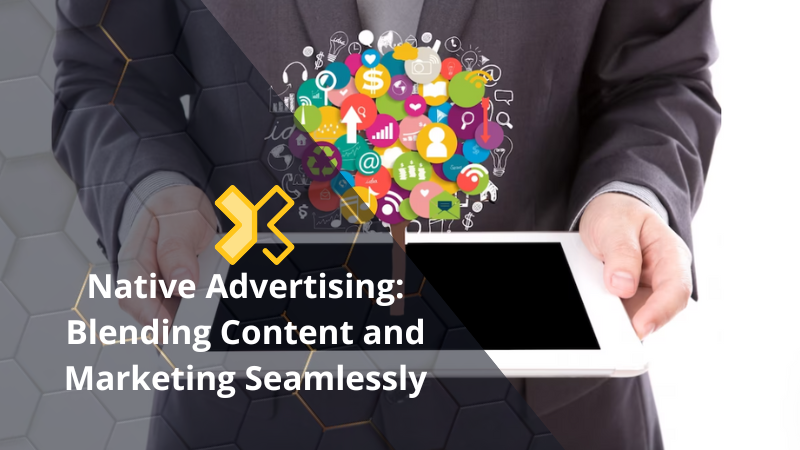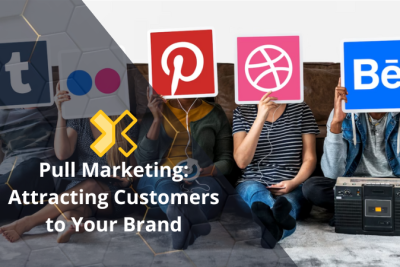
Native Advertising: Blending Content and Marketing Seamlessly

Native advertising is a digital marketing strategy that seamlessly blends promotional messages with valuable and relevant content. Essentially, native advertising is a paid-for content placement that is designed to look and feel like the editorial content that surrounds it. By providing consumers with a non-intrusive advertising experience, native advertising has rapidly grown in popularity in recent years.
- What is Native Advertising?
- The Benefits of Native Advertising
- Native Advertising vs. Traditional Advertising
- Creating an Effective Native Advertising Strategy
- The Role of Sponsored Content in Native Advertising
- Native Advertising Trends in the UK
- Measuring Success in Native Advertising
- Integrating Native Advertising with Content Marketing
- The Future of Native Advertising
What is Native Advertising?
Native advertising is a form of digital advertising that seamlessly combines promotional messages with non-promotional content. Its purpose is to provide a more engaging and less intrusive way to reach the target audience, by delivering advertisements that look and feel like the surrounding editorial content.
Native ads can take various forms, including in-feed ads, sponsored content, recommended content, and promoted listings. They can appear on various platforms, such as social media, news websites, and mobile apps, and can target specific demographics and interests.
The Benefits of Native Advertising

Native advertising has become a popular marketing strategy due to its numerous benefits. By providing a seamless transition between branded content and editorial content, native advertising has proven to be more effective than other forms of digital advertising.
One major benefit of native advertising is that it enhances user experience. Native ads are less intrusive than traditional banner ads, and they blend in with the surrounding content, making them less disruptive to the user's browsing experience. This translates to a higher likelihood of users engaging with the content and taking action.
Native advertising is also more effective at increasing brand awareness and engagement. The ads are designed to match the form and function of the platform, which makes them more relevant and attractive to the target audience. As a result, native ads see higher click-through rates and engagement rates compared to traditional advertising formats.
Another benefit of native advertising is that it allows for more precise targeting. Because native ads are placed within specific content, they can be targeted to specific audience segments based on their interests, behaviors, and preferences. This precision targeting ensures that the right people see the ad at the right time, increasing the likelihood of conversion.
Overall, native advertising provides an effective way for brands to connect with their target audience in a way that is engaging, relevant, and non-intrusive. By delivering valuable content that seamlessly integrates with editorial content, native advertising has proven to be a valuable tool in any digital marketing strategy.
Native Advertising vs. Traditional Advertising
While traditional advertising relies on interruptive tactics to reach a target audience, native advertising aims to blend seamlessly with the user experience, providing value and relevance to the consumer. This approach has proven to be more effective in engaging consumers and building brand awareness.
Native advertising differs from traditional advertising in several key ways. First, native ads are designed to match the visual form and function of the platform on which they appear, whether it's a social media feed or an online news article. This allows the ad to blend in with the surrounding content and not disrupt the user experience.
Secondly, unlike traditional advertising that often focuses solely on promoting a product or service, native advertising seeks to provide value to the consumer by offering information or entertainment in the form of editorial content. By doing so, native ads can build trust with their target audience, making them more likely to engage with the brand in the future.
Finally, native advertising is often seen as a more cost-effective way to reach a target audience. Traditional advertising methods, such as TV commercials or print ads, can be expensive to produce and distribute on a large scale. In contrast, native ads can be created in-house and distributed across a variety of digital platforms at a fraction of the cost.
Native Advertising vs. Traditional Advertising: Which is Better?

While both native and traditional advertising can be effective in reaching a target audience, the approach that is right for each brand ultimately depends on their specific marketing goals and target audience.
For brands looking to build trust and engagement with their target audience, native advertising may be the better option. By blending seamlessly with the user experience and providing value in the form of editorial content, native ads can create a more positive association with the brand in the mind of the consumer.
On the other hand, for brands looking to achieve a broad reach and raise brand awareness quickly, traditional advertising methods may be more effective. TV commercials, for example, can reach millions of viewers at once and provide a more memorable brand experience through sound and sight.
Ultimately, the decision between native and traditional advertising should be based on a thorough understanding of the brand's marketing goals, target audience, and available resources.
Creating an Effective Native Advertising Strategy
Developing a successful native advertising strategy requires careful planning and execution to ensure seamless integration between content and promotion. Here are some tips to help you create an effective native advertising strategy:
- Identify your target audience: Before creating any native ad content, it's essential to understand your target audience's habits, interests, and demographics. Use data analysis and market research to develop user personas that will inform your content creation and distribution approach.
- Integrate your brand message: Native advertising blends editorial content with promotional messages, so it's essential to ensure that your brand message is integrated naturally and aligns with your content's tone and message. Avoid overtly salesy language and focus on delivering value to the user.
- Choose the right platform: Different native ad platforms suit different content types and industries. Consider the strengths of each platform and choose ones that are compatible with your brand message and target audience.
- Create compelling editorial content: The core of native advertising is engaging and valuable editorial content that resonates with your target audience. Invest in creating high-quality, informative, and interesting content that offers value to the reader.
- Test and optimize: Monitor the performance of your native advertising campaigns regularly and use A/B testing to evaluate different ad formats, headlines, and CTAs. Use data insights to optimize your campaigns and improve their effectiveness over time.
The Role of Sponsored Content in Native Advertising
Sponsored content is a key element of native advertising, primarily because it offers an effective means of integrating promotional messages within valuable and relevant content. Many brands use sponsored content to build trust with their target audiences, as well as to establish their authority within a particular industry or niche.
When crafting sponsored content, it’s important to ensure that it aligns with the editorial standards of the platform or publication on which it appears. To achieve this, brands should work closely with publishers, editors, and content creators to develop content that resonates with their target audiences and feels organic to the platform in question.
In many instances, sponsored content will require a small disclaimer to ensure transparency for readers. This disclaimer will typically state that the content has been created in collaboration with the brand or advertiser and sits outside the publication’s editorial content.
| Best Practices for Creating Sponsored Content: |
|---|
| • Collaborate with publishers, editors, and content creators to develop content that aligns with the platform’s editorial standards. |
| • Ensure sponsored content is relevant, valuable, and interesting to your target audience. |
| • Include a disclaimer to ensure transparency for readers. |
Ultimately, sponsored content can make up a significant part of a brand’s native advertising strategy. By taking a collaborative and thoughtful approach to sponsored content creation, brands can drive engagement, build trust, and establish themselves as thought leaders within their respective industries.
Native Advertising Trends in the UK
Native advertising is a rapidly growing sector in the United Kingdom's advertising industry. With the rise of digital marketing, more and more businesses are turning to native advertising to deliver their promotional messages in an engaging and unobtrusive manner. In-feed ads are a particularly popular format, with social media platforms such as Facebook and Instagram driving native ad campaigns.
The Rise of In-Feed Ads
In-feed ads are a type of native ad that appear within a user's social media newsfeed, often looking like a regular post. According to data from eMarketer, in-feed ads account for the largest share of native ad spending in the UK, with a 57.2% share of the market in 2021.
| Benefits of In-Feed Ads | Challenges of In-Feed Ads |
|---|---|
| Seamlessly blend into the user's feedHigher engagement rates compared to traditional adsOpportunity to reach a broader audience | May not be easily distinguishable as adsCan be costly to produce high-quality contentMay require significant testing and optimization |
While in-feed ads have their advantages, advertisers must also tackle the challenge of creating content that is both valuable and compelling to the viewer. Native advertising campaigns must be carefully planned and executed to ensure maximum effectiveness.
The Importance of Social Media Platforms
Social media platforms are driving the growth of native advertising, with Facebook, Instagram, and Twitter being among the top platforms used by businesses in the UK. According to a survey by eMarketer, 66% of UK marketers plan to increase their native advertising budget on social media platforms in 2021.
In addition to social media, publishers such as The Guardian and BuzzFeed are also incorporating native advertising into their content offerings, providing businesses with additional opportunities to reach their target audience.
Overall, the use of native advertising in the UK is a rapidly growing trend, with businesses recognizing the importance of blending valuable content with effective marketing. As technology and consumer behaviors continue to evolve, it is likely that native advertising will remain a key component of digital marketing strategies for years to come.
Measuring Success in Native Advertising
Measuring the success of a native advertising campaign requires a combination of traditional and digital metrics, as well as an understanding of the brand's objectives and target audience.
One key metric is click-through rate (CTR), which measures the number of clicks an ad receives divided by the number of impressions it generates. While CTR provides insight into the ad's appeal, it does not necessarily translate into conversions or sales. Therefore, it's important to look at additional metrics, such as conversion rate and return on investment (ROI).
Conversion rate measures the percentage of users who complete a desired action after clicking on an ad, such as filling out a contact form or making a purchase. ROI, on the other hand, compares the cost of the campaign to the revenue generated, providing a more comprehensive view of the campaign's success.
It's also essential to track engagement metrics, such as time spent on content, social shares, and likes. These metrics are indicative of audience engagement and help identify what content resonates most with the target audience.
Examples of successful native advertising campaigns include Netflix's "Orange is the New Black" campaign on The New York Times, which generated 4.5 million social media interactions, and Airbnb's "Live There" campaign on VICE, which achieved a 3.3% click-through rate and 10 million total impressions.
Integrating Native Advertising with Content Marketing
Native advertising and content marketing may seem like distinct approaches to brand promotion, but they share a common goal: engaging consumers with valuable and relevant content. By integrating native advertising with content marketing, brands can amplify their reach and create a more cohesive brand image.
The key to successful integration is to create a seamless experience for the consumer. Brands should aim to create native ads that fit naturally within the context of their content marketing strategy. This means carefully considering the placement and format of native ads to ensure they complement and enhance the user’s experience.
Another important consideration is to ensure consistency in messaging and branding. Native ads should align with the brand’s overall marketing strategy and messaging, while also providing a unique, value-driven experience for the consumer.
Brands can also leverage their content marketing efforts to drive traffic to their native ad campaigns. By strategically placing native ads within relevant content pieces, brands can encourage users to engage with their ads and take action.
Ultimately, integrating native advertising with content marketing can be a powerful way to drive engagement, build brand awareness, and boost conversions. As consumers continue to demand more valuable and relevant content, brands that focus on creating integrated, cohesive experiences are likely to see the greatest success.
The Future of Native Advertising
As digital marketing continues to evolve, it's important to consider the potential future trends of native advertising. With changing consumer behaviors and advancements in technology, native advertising is likely to adapt and evolve in the coming years.
Rise of Video Content
One potential future trend in native advertising is the rise of video content. With the increasing popularity of video platforms like TikTok and Instagram Reels, brands may look to incorporate video into their native advertising campaigns for increased engagement. This could mean creating short, visually appealing ads that blend seamlessly with the platform's content, or partnering with influencers to create branded video content.
Increased Personalization
Personalization has become increasingly important in marketing, and native advertising is no exception. In the future, we may see more highly personalized native ads that are tailored to a user's interests and behaviors. This could involve using data to target specific audiences and creating more personalized ad experiences that feel more relevant and less intrusive.
Integration with Augmented Reality
Augmented reality (AR) technology has already been used in native advertising campaigns, but in the future, we may see even more integration with AR. This could mean creating AR experiences that allow users to interact with products in a more immersive way, or using AR to create more engaging and interactive ads that capture users' attention.
Increased Regulation
As native advertising continues to grow in popularity, there may be increased regulation around how it's used. This could mean more stringent requirements around disclosure to ensure that users understand when they're seeing an ad, as well as guidelines around the use of data to personalize ads.
Overall, the future of native advertising looks promising, with potential for increased personalization, immersive experiences, and more engaging ad formats. As brands continue to look for ways to reach their target audiences in a meaningful way, native advertising is likely to remain a valuable tool in the digital marketer's toolkit.
If you want to know other articles similar to Native Advertising: Blending Content and Marketing Seamlessly you can visit the category MARKETING.
Leave a Reply






It may interest you...